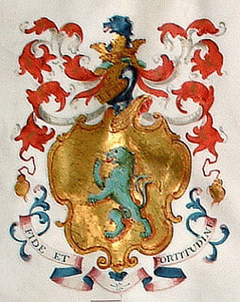In the annals of genealogical fantasists the Conde de Clonard is an interesting case. The condes de Clonard descend from an Irish mercantile family in eighteenth-century Spain, the Suttons of county Wexford, of whom Don Miguel Sutton (hispanized ‘de Soto’ or ‘de Sotto’) was ennobled in 1770 as the ‘conde de Clonard’, taking his title from an ancestral holding of his family in Wexford. Interestingly, in the same generation, another Wexford Sutton, apparently a third or fourth cousin, settled in France, was also prominent in mercantile circles (no doubt participating in the same Atlantic trading network) and was ennobled in France as the “Comte de Clonard.” These two related Sutton branches in France and Spain shared a tradition that the Wexford Suttons were descended from Thomas, a younger son of John Sutton alias Dudley, 1st Baron Dudley, Lord Lieutenant of Ireland, who died in 1487. However, John, Baron Dudley, had no son Thomas; and the available published documentation on the Wexford Suttons offer no evidence to support a descent from the baronial Sutton Dudleys.
The current conde de Clonard has stated that his family has an illuminated pedigree, 183 centimeters high, prepared and signed by James MacCulloch, Ulster King of Arms, in 1764, giving a genealogy of the Wexford Suttons and stating their descent from John, Baron Dudley (a brief passage from this is quoted here). This would be an interesting document to examine in its entirety, since British documents created to satisfy other nations’ social or legal requirements of noble ancestry have not been carefully studied. They likely were never common; and they were surely subject to a great deal of abuse—either outright forgery, or at least or knowing exaggeration or falsification of information in them even by legitimate authorities. For an example of such a document, allegedly created by King James VI & I in 1616 for use in the duchy of Stettin-Pomerania, see another blog post here.

The current conde de Clonard is José Antonio Guijarro Torija y de Sotto. He is not descended from the Wexford Suttons in the male line, however: the male line of the condes de Clonard went extinct with the death of Serafín de Sutton y Aguilar, the fifth conde de Clonard, in 1923; the current count is grandson of Don Serafín’s elder daughter. Dormant during the Franco years, the title was revived in 1981 in favor of a son of one of Don Serafín’s younger daughters, who became the 6th conde de Clonard; it subsequently passed to his brother and then to that brother’s son; however José Antonio Guijarro Torija, grandson of Don Serafín’s eldest daughter, challenged his cousin for the title, on the grounds of descent from the senior daughter, and the title was confirmed to him on 2 September 2002.
The Sutton descent of this Spanish count is itself interesting and worthy of study. But even more interesting are the fantasies to which the current count subscribes. He accepts and stridently defends the dubious descent of the Wexford Suttons from the baronial Sutton-Dudleys as alleged in the 18th century; on top of this he subscribes to (and appears to have invented) two distinct additional fantasies. The first fantastic claim is that his (perfectly legitimate) Spanish title ‘conde de Clonard’ happens to correspond to an older Anglo-Irish title, ‘earl of Clonard’, established in the 12th century; he therefore calls himself (by what arithmetic one cannot divine) the 29th earl of Clonard. That such a title is found nowhere in the history of the English or Anglo-Irish peerage does not deter him.
But Clonard’s second fantasy is more extraordinary by far. He alleges that his ancestor, Raymundo de Sotto y Campuzano, 4th conde de Clonard (b. 1822; d. 1894), was actually secret husband of Queen Isabella II of Spain, and father by her of both her actual successor on the Spanish throne, King Alfonso XII (b. 28 November 1857), and of his own successor as conde de Clonard, Don Serafín de Sotto y Aguilar, the 5th conde (b. 20 June 1856; d. 1923). Therefore Clonard alleges that the current Spanish royal family is descended in the male line from the Wexford Suttons, and therefore that they are his own very close kin. (It should be pointed out that these condes de Clonard are real historical figures, and that Raymundo de Sotto y Campuzano, 4th conde de Clonard, had a real wife, Agustina Aguilar, daughter of Juan de Dios Aguilar del Viso; according to standard biographical sources she and not the Queen was the mother of the 5th conde.)
All this is heady stuff. Clonard’s baroque website seeks to establish all these fantasies, it seems, by repetition, along with the time-honored stylistic choice of gold text on purple background (the choice of dignified texts since at least the sixth-century Codex argenteus).
To an observer of internet fantasists it seems unusual that one who already won for himself an authentic comital title should also baldly (and brashly) grasp at fantasies: most fantasists after all are commoners with anonymous families who desire something more glamorous (Michael LaFosse, Terence McCarthy). More astonishing still that the Conde’s particular fantasy should make such a bald, revisionist claim about the ancestry of his own sovereign. But it should hardly be surprising that the desire for self-aggrandizement through genealogical fantasy should afflict even those who have already inherited something that would be a fantasy for others.

2 Trackbacks/Pingbacks
[…] Conde de Clonard has penned a predictable response to an earlier entry in my blog in which I made note of his absurd genealogical claims. The best part of his rant is that it […]
[…] Grazebrook: there is no room for the alleged descent of the Wexford, Ireland Suttons (a quo the condes de Clonard & comtes de Clonard) from the first Lord Dudley. This was written by Nat Taylor. Posted on Thursday, September 18, […]
Post a Comment